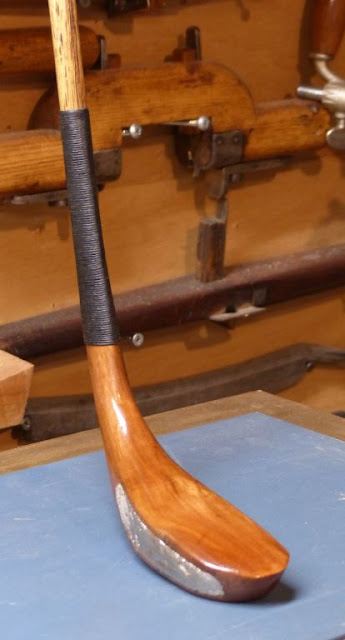P until the 1890s, the golf club head was affixed to the shaft using a 4-6" taper on the head glued to a matching taper on the end of the shaft. Woodworkers call this joint as a scarf joint, while Scottish golf clubmakers call it a "scare joint". Besides golf, connecting two pieces of wood with adjoining tapered ends has many applications.
 |
| A simple scarf joint can be used to connect mouldings, siding, boat masts, etc. |
 |
| An angled scarf can be used to attach the headstock of a guitar to the neck. |
Simple scarf joints are connected together with opposing angled cuts, then glued and may use some sort of external buttressing. More complex scarf joints can use interlocking arrangements to provide more gluing surface and stability.
For hundreds of years, a simple scare joint was used for golf clubs. The year 1891 marked the gradual disappearance of the scare joint when Robert Anderson patented the socket neck. Since 1904, the majority of woods have been attached with the socket method where the shaft bores through a hole in the clubhead. The socket design is easier to manufacture. Traditionalists continued to use the scared neck design claiming better feel and tempo. The great Harry Vardon played all of his competitive rounds with the 'scare', and Walter Hagen won his fourth Open Championship in 1929 at Muirfield with one, the last major victory for the 'scared'. In his 1906 The Complete Golfer, Vardon makes a convincing argument for the continued use of the scared neck versus the socket neck:
  |
Early Anderson socket neck club, left. Photo courtesy Sotheby's
Shaft end visible on the sole through bored hole in clubhead on a early 20thcentury club, right. |
 |
| Golfers had there choice of socket or scared clubs in the early 20th century. From Spalding's Official Golf Guide 1902 |
 |
| The scared joint typically ranges from 4-6" |
 |
| Putter |
 |
Block plane used to make the scare on the neck of the clubhead.
The length and angle of the scare should be the same for the shaft and clubhead neck
The angle can be adjusted surprisingly well with the plane and your eye.
|
 |
| The grain of the shaft on the butt and tip ends should be oriented parallel to the line of flight |
 |
Mark off the length of the neck scare to the shaft. The goal is to plane away so that a reed-like tip is achieved at the same time that the appropriate length is reached.
|
 |
Both ends of the planed surface should end in points.
|
 |
| Hide glue has the advantage of being easily reversible. It also bonds to itself. Hot hide glue draws the two pieces together. In some applications, such as a rub joint, where two flat surfaces are rubbed together a few times, no clamp is needed. Traditionally, the clamp for hot hide glue was simply some twine wrapped tightly around the scare joint. |
 |
Use clamps when working with modern glues.
|
 |
| J. H. Taylor's description of the scare joint in The Book of Golf and Golfers |
 |
William Innes of Blackheath, by Lemuel Francis Abbott, 1790.
Not only is the caddie carrying multiple clubs, but he also has a wine bottle in his pocket. Gatorade in plastic bottles had not yet been popularized.
|
Illuminated letter "U" by Thomas Hodge from Golf, The Badminton Library























Comments
Post a Comment